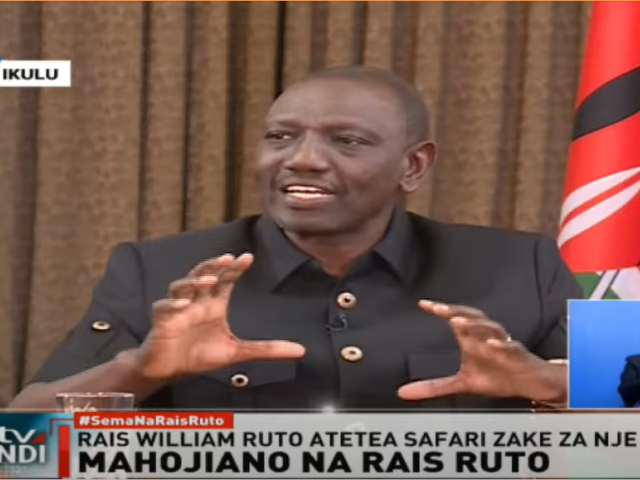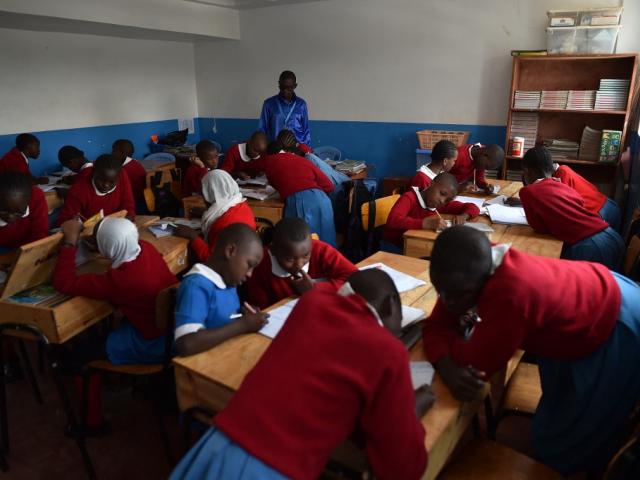-
The president made incorrect claims about Kenya’s tax as a percentage of gross domestic product compared to Japan’s, and that education spending accounts for nearly 30% of Kenya’s total budget.
-
He has also claimed that Kenya spends KSh650 billion a year on education, from primary school through to tertiary, but however you slice it, the figure is lower.
-
Ruto repeated exaggerated claims that his administration has doubled the amount spent on technical and vocational education and training, but the truth is closer to an increase of just over 30%.
Kenyan president William Ruto has been visiting foreign capitals with a message to his compatriots abroad to invest at home.
Ruto’s extensive travel has been a matter of national debate, with one count estimating that he has made nearly 50 trips since taking office in September 2022.
He is due to visit the US in May 2024, following trips to Ghana, Guinea and the Central African Republic in April and Japan in February. The government's defence of the frequent trips is that they have earned the country at least KSh2 trillion (about US$15 billion).
Following Ruto’s trips to Japan and Ghana, we examined some of the repeated claims he has made in his talking points.
Ruto has controversially pressed Kenyans to pay more taxes, having vowed to reduce debt and increase government income. While in Japan, he said it was unsustainable for Kenya to rely on debt or aid.
“If we have to develop our country, Kenyans must roll up their sleeves and develop their country,” he told Kenyans living in Japan.
He continued: “I was looking at the numbers, today, Japan, their tax as a percentage of GDP is at 34.8%.”
Taxes are compulsory payments to governments for public purposes. Gross domestic product (GDP) is an overall indicator of how much an economy produces each year.
The tax-to-GDP ratio helps to determine how a government allocates its resources. It also shows how efficient a government is at collecting taxes and how much people and companies are taxed, which can affect investment. Developed countries tend to have a higher tax-to-GDP ratio than developing countries.
Data from the Organisation for Co-operation and Development (OECD), an economic grouping of 38 mainly European countries, shows that Japan had a tax-to-GDP ratio of 34.1% in 2021, the latest year for which this information is available. Japan is a member of the OECD.
However, the OECD previously told Africa Check that it interprets taxes differently – as including “compulsory social security contributions paid to the general government in the total tax revenues”.
Such contributions include unemployment insurance, which is money you get when you don't have a job, are injured or sick; money for your old age, disability or for your family if you die; and getting money back for medical bills or getting free medical care.
The president’s claim is specific to tax so it would be misleading to use the OECD figures.
Japanese tax as share of GDP 15% lower than claimed
Africa Check asked Prof Iizuka Nobuo, an economics professor at Japan’s Kanagawa University, to help us verify this claim. Iizuka has studied Japan’s revenues and its GDP.
Citing data from Japan’s cabinet office, the “annual report of national accounts for 2022”, Iizuka told Africa Check in an email that as a percentage of nominal GDP, tax revenue was 20%, while social security contributions were 13.7%.
We also checked with Japan’s ministry of finance, which provided a public finance fact sheet outlining the country’s economic landscape.
Japan’s financial year runs from 1 April to 31 March. For the fiscal year ended 2022, the country’s tax as a percentage of GDP was 19.7%.
Neither of these figures reflect those given by Ruto. – Tess Wandia
Ruto repeated this claim in Japan and in Ghana. He appeared to cite 2021 OECD data, which put Kenya’s tax-to-GDP ratio at 15.2%. For the same year, the World Bank put Kenya’s tax as a percentage of GDP at 13.3%.
An OECD official previously told Africa Check that the World Bank’s data does not include social contributions, which is the reason for the difference from the OECD data.
For more recent data, we checked with Kenya’s national treasury which publishes the budget review and outlook paper every year.
According to the latest report, published in September 2023, taxes amounted to KSh1.89 trillion against a GDP of KSh14.27 trillion, giving a tax-to-GDP ratio of 13.2% for the 2022/23 financial year.
This is the latest year for which data is available.
Ruto appears to be quoting OECD data, which also includes social contributions. However, according to the World Bank and Kenya’s national treasury, taxes as a percentage of GDP are lower.
Therefore, we rate the claim incorrect.
Ruto claimed his administration had doubled the money allocated to technical and vocational education and training (TVETs), to grow skills needed globally.
TVET specialises in providing students with knowledge, skills and competences for specific occupations.
Kenya’s national assembly approves the appropriations act, the law that allocates money to government programmes and authorises the spending of public funds.
On 26 June 2023, Ruto signed the most recent appropriations law. This allocated KSh28.32 billion, a figure cited in a state house news brief on 26 March 2024.
The previous allocation was KSh24.93 billion.
The office of the controller of budget authorises all government expenditure in accordance with the approved budgets. The office also publishes quarterly reports showing how funds have been allocated to different sectors.
However, the controller of the budget’s report released in February 2024 indicated an increased allocation to KSh32.9 billion in 2023/24.
The allocation to TVETs has therefore not doubled but increased by KSh7.97 billion – or 32% – over the 2022/23 budget. So far, we have not seen any evidence that the allotment has been doubled. –Tess Wandia
Kenya's education sector includes basic, technical and tertiary education, as well as the Teachers Service Commission, the employer of all public school teachers.
While in Japan, Ruto said Kenya was spending KSh650 billion or $5 billion a year on education. He made the same claim in Ghana.
The latest controller of the budget report for the current 2023/24 financial year showed that education received KSh628.6 billion. This was later increased to KSh689.6 billion in the November 2023 supplementary budget, or $4.3 billion using the exchange rate of KSh160.19 per US dollar, the rate on 7 February 2024 when Ruto made the claim.
But that's only for the 2023/24 financial year, which ends on 30 June. We looked at previous years.
|
Allocation to Kenya’s education sector (2019-2024) |
|
|
Financial year |
KSh billion |
|
2019/20 |
500.3 |
|
2020/21 |
489.4 |
|
2021/22 |
527.3 |
|
2022/23 |
568.5 |
|
2023/24 |
689.6 |
Source: Controller of budget report
The annual allocation in the four previous fiscal years is not KSh650 billion. Even the average over five years, KSh555 billion, or for the last two financial years, KSh629.1 billion, is lower than Ruto’s figure.
We rate this claim as exaggerated. – Makinia Juma
Ruto made this claim in Japan and in Ghana.
The controller of the budget's most recent report, published in February 2024, put the national government’s budget for the financial year 2023/24 at KSh4.54 trillion.
The country allocated KSh689.6 billion to education. “This amount represents 15.2% of the revised gross national budget,” the controller of budget said.
However, the Kenyan constitution recognises two “distinct and interdependent” levels of government – the national government and 47 county governments.
In 2023/24, counties had a total budget of KSh557.4 billion, of which KSh43.6 billion or 7.8% was allocated to education. (See our workings here.)
The total budget for the two levels of government is KSh5.1 trillion. The total education allocation is KSh733.2 billion, or 14.4%.
The available data does not support the president's claim of 30%. – Makinia Juma






Add new comment